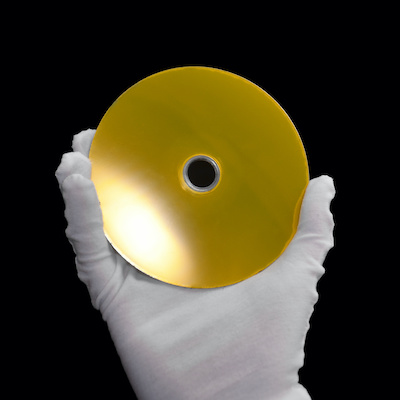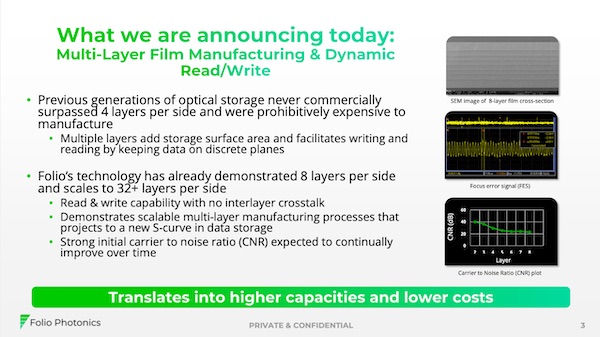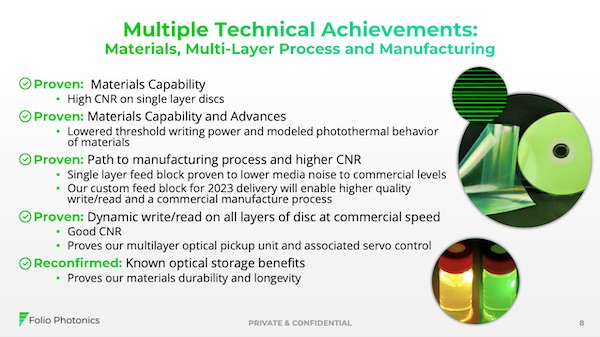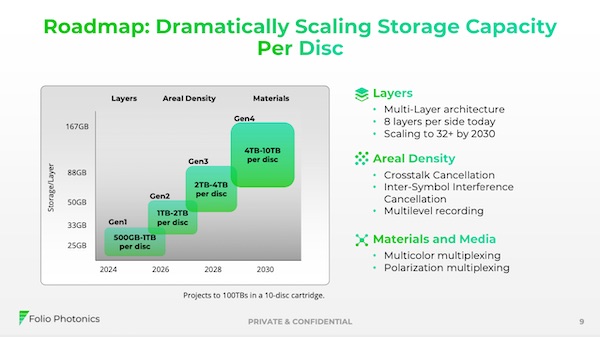Folio Photonics with Multi-Layer Optical Disc Storage Technology
For active archiving, starting at 10TB/cartridge (1TB/disc)
This is a Press Release edited by StorageNewsletter.com on August 30, 2022 at 2:02 pmFolio Photonics, Inc. achieved a breakthrough in multi-layer optical disc technology that will enable an unprecedented level of cost, security and sustainability advantage.

Leveraging patented advancements in materials science, it has developed the first economically viable, enterprise-scale optical storage discs with dynamic multi-layer write/read capabilities, which will enable the development of low-cost/high-capacity disc storage.
“Folio Photonics is on a path to engendering far greater data densities than was thought possible several years ago,” said John Monroe, Further Market Research. “Using next-gen materials, patented polymer extrusion, and film-based disc construction processes (distinct from mere optical layering), in concert with customized optical pickup units (OPUs), Folio Photonics appears poised to deliver a new optical technology that enables eight or 16 film layers per side per disc, as opposed to only three optical layers per side per disc for archival discs today, with a roadmap to add additional layers over time.”
Data growth is overwhelming existing storage technologies, and today’s outdated enterprise storage technologies fail to address 3 key pain points of cost, cybersecurity and sustainability. The high cost of storage is untenable with exploding data growth, cyber threats continue to escalate, and data centers are a major contributor to energy/water usage and CO² emissions. Current HDD and LTO tape roadmaps reflect insufficient technological advancement to meet user needs and desired price points in the future.
Folio’s technology milestone proves the feasibility of its materials, manufacturing and optics and shifts the company from the research phase to product development. With disc availability targeted for 2024, Folio’s multi-layer disc capacity is expected to start at 10TB per cartridge (1TB per disc) with a roadmap to multi-terabyte capacities. The roadmap is enabled by the addition layers due to its easily scalable polymer co-extrusion process as well as increases in capacity per layer.
“Our talented engineering team – under the leadership of founder and CIO Dr. Kenneth Singer – has pioneered a fresh approach to optical storage that overcomes historical constraints and puts unheard of cost, cybersecurity and sustainability benefits within reach,” said Steven Santamaria, Folio Photonics CEO. “With these advantages, Folio Photonics is poised to reshape the trajectory of archive storage.”
These optical discs will provide a combination of game-changing characteristics that make data archives active.
The company is well positioned to be a leader in the archival storage market, projected to be $10 billion+, 2.68ZB+ in 2025. It plans to start with adoption in the immutable active archive use case and expand to become a standard for all archive data. Folio’s manufacturing advantages drive room for channel/partner margin and profitability and position the company for sustainable growth and continued investment in the business.
“Archival storage data comprises up to 80 percent of all data according to industry estimates, and Folio Photonics is in a strong position to be a leading player in this large, fast-growing market,” said Fred Moore, president, Horison Information Strategies. “Archival data is typically unchanging, presenting itself as ‘write once’ and requiring immutability. At the same time, AI, ML and big data analytics are increasing activity and accessibility requirements for archival storage systems. As a result, the demand for immutable active archives will only increase as immutability and higher performance requirements reshape the exploding secondary storage paradigm.”
Unlike tape, Folio Photonics active archive storage will provide random access to archives to ensure effective data retrieval. Unlike HDD, its active archive storage is Immutable by Design and offers a 5x lower acquisition price – roughly $25/TB for HDDs and less than $5/TB for Folio. Its discs are highly sustainable and will provide 80% power savings over HDDs. In addition, its active archive storage is not vulnerable to electromagnetic pulse (EMP) attacks, offers an air gap to ensure cybersecurity and provides a media lifespan of 100 years.
“Folio’s next-gen storage media will radically reduce the upfront cost and TCO while making data archives active, cybersecure, and sustainable – an ideal combination for data center and hyperscale customers. We believe that it will disrupt and reenergize the multi-billion-dollar data storage industry with its breakthrough financial and sustainability upside,” added Santamaria.
[1] Fred Moore, Horison Information Strategies, Reinventing Archival Storage, 2021.
[2] John Monroe, Further Market Research, The Escalating Challenge of Preserving Enterprise Data, 2022
Comments
This news confirms that secondary storage is an eldorado. It is not new as many companies tried and continue to innovate to tackle challenges due to high data volumes, data access needs, long term preservation requirements, more recently cyber threats and of course cost.
Cloud storage is an approach, tapes of course proven for many decades at an attractive TCO with the LTO family and some interesting developments like the 580TB Fujifilm/IBM project, now optical as a cycle with Folio Photonics introducing more dense discs.
This happens during a cycle of active research and development around glass, holographic and DNA data storage. Clearly something is happening in this storage domain where cold data meet cold storage. An angle of this is about rewritable media but for archiving clearly WORM is the norm. Another reminder, backup is a copy maintaining data at the source while archive is a move and represents the last data image, if you lose it, no other ways exist to access these data.
As for any media, developments questions fall into density to reach new capacity levels, access and transfer time and media integrity and longevity over time. For deep archive, clearly century is the atom, for other verticals or specific archiving a few years or a few decades could be required but all these need a strong media.
Optical is not new and it was always a way to compete vs. tape, both presenting different advantages and properties and even some similarities on values. There are various generations of medias like CD, DVD, magneto-optical with 9.1GB, Ultra Dense Optical (UDO) with 30GB, of course Blu-ray and Archival Disc with different attributes illustrating vendors battle on colored laser.
At that time vendors were Plasmon, HP, IBM, Sony, with OEM deals, we also saw Aprilis, InPhase Technologies that finally got bankrupt in 2011. Akonia Holographics acquired InPhase assets in 2012 trying to leverage and extend past developments but finally Apple swallowed Akonia in 2018. So where is the money here to sustain the business? Or is there a real market to allow such developments efforts? It seems to be but...
Around 2014, Sony and Panasonic have announced their Archive Disc with 30GB capacity. Some of us also remember Optical Archive Inc., initiated at Facebook and founded by Frank Frankovsky, very active in the Open Computing Project (OCP), that finaly ended in 2015 in the arms of Sony and its ODA product line. This solution was based on 50GB Blu-ray discs and Facebook even tested optical libraries with 10,000 discs. As a side comment, surprisingly, Frankovsky LinkedIn page doesn't mention at all this optical episode.
Almost 20 years ago, we had some tries with PowerFile and its DVD and CD-ROM MFX library lines with 200 discs exposing industry standard protocols such CIFS or NFS to facilitate applications connections and integrations but also via specific drivers. The story ended in 2010. We saw also Sony with its PetaSite library or Panasonic with its Freeze-ray product. We also discovered an Australian vendor, Digistore Solutions Holdings, who designs and builds Centurion iHub, a Blu-ray based optical library with 200x100GB discs which represents 20TB.
So clearly the battle is on the disc itself with challenges on capacity and throughput, the library design and integration are considered a secondary phase to build large systems able to store petabyte of data often the responsibility of OEMs. The other need comes from the necessity to provide an easy access to stored data. It came from HSM where secondary storage presence and complexity were masked to the application and users offering transparent access to any data, online or offline, this was called nearline. Users felt only some latency during retrieval data process. Active archiving is built on front-end systems with HDDs and now flash for caching, indexing and cataloging, exposing datasets via NFS or CIFS and more recently via S3 API. This active archive model segments solutions from deep archive.
We recently spoke with Fred Moore and we introduced the term instant archive with flash in the loop to be more specific. It's interesting to see that device and media manufacturers claim to provide active archive with something deep in the data chain. Being active is more how the system presents itself to the outside world vs. speed of the media and access time to the data present on the media. At scale, having a rich front-end is mandatory as it masks the complexity and offers an easy integration to the environment facilitating users usages.

Back to Folio Photonics, the company is a spun-off from Case Western Reserve University and its National Science Foundation Center for Layered Polymeric Systems. So far the company raised $12.3 million according to Crunchbase and we anticipate a new round to support this ambitious project. The team is led by Steven Santamaria as CEO, Kenneth D. Singer, founder and chief innovation officer, recognized professor and researcher in nonlinear optics, optical and electronic properties, and devices formed from organic materials with 200 publications and several patents, and Irina Shiyanovskaya serving as COO and CTO also having produced over 50 publications and 11 patents in optics, organic electronics, flexible displays and photo-physics. John Taylor is a board member, and was chairman and CEO of Panasonic North America and actively promoted the Freeze-Ray product mentioned above. A strong respected team that tries, once again, to shake the optical wave and the storage archiving segment.

What Folio announced is a breakthrough in optical development with a new media model built with a new substrate based on multi-layers film material that, unified, enable new capacity. Today the company delivers 8 layers per side per disc and the technology is ready for 32 layers.
By nature, this media is WORM so suited for archiving and ready to resist to cyber attacks.
The team is confident to offer 1TB/disc delivered in 10TB cartridge or magazine. The other goal is to break the tape cost per terabyte ratio and reach $5/TB. The other dimension resides in its inactive or passive media participating to the drastic energy reduction, like tape. The media roadmap is pretty ambitious with 4 to 10TB per disc around 2030.

Folio doesn't share any numbers regarding read/write operations throughput and doesn't get any info also on the disc format.
Now the question of the go-to-market is interesting with OEM as the right model with these partners ready to build their own modern optical libraries with all elements to offer active archive solutions, easy to connect to applications and environments making media, devices and internal stuff completely transparent. For the industry, this R&D effort is significant illustrating on-going needs for large capacity archiving systems.














 Subscribe to our free daily newsletter
Subscribe to our free daily newsletter


